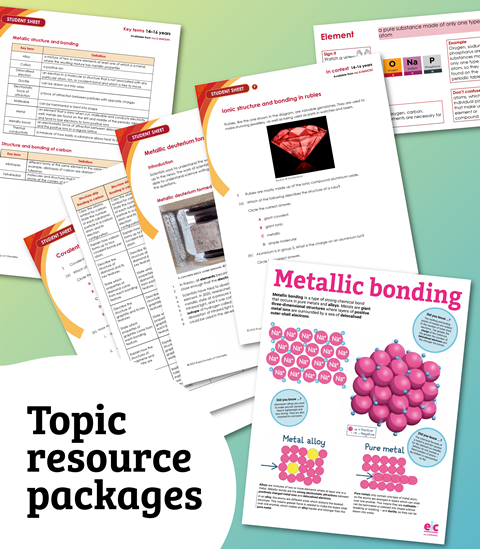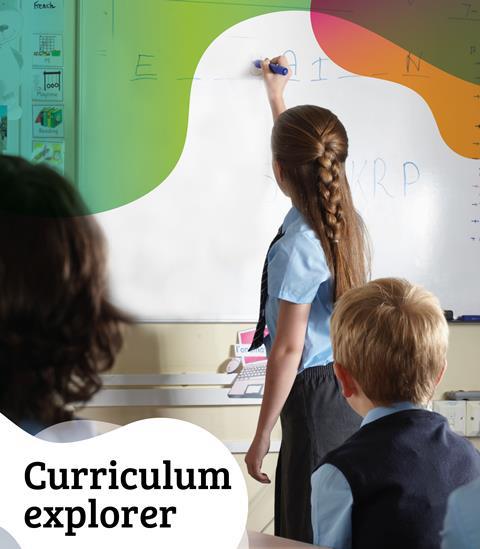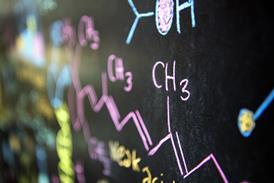All Higher-order thinking and metacognition articles
-
 Question sheet
Question sheetCondensation polymerisation | Review my learning worksheets | 14–16 years
Identify learning gaps and misconceptions with this set of worksheets offering three levels of support
-
 Resource
ResourceSolutions | Stretch and challenge | 11–14 years
Challenge learners to apply logical reasoning and their knowldge of particle model to explain experimental observations
-
 Resource
ResourceAlkenes | Review my learning worksheets | 14–16 years
Identify learning gaps and misconceptions with this set of alkenes worksheets offering three levels of support
-
 News
NewsIntegrating scaffolding and metacognition into titrations
Can a flipped-practical approach encourage thinking and self-reflection?
-
 Resource
ResourceDecision tree: what type of bonding? | 14–16 years
Use this decision tree to help your learners find answers to questions about structure and bonding by scaffolding their thinking
-
 Resource
ResourceAtoms and ions of copper | Johnstone’s triangle worksheets | 14–16 years
Use these worksheets to develop learners’ understanding of atoms and ions, including a demonstration of a metal displacement reaction
-
 Resource
ResourceDecision tree: acid, base or buffer? | 16–18 years
Help learners understand which equation they need to answer questions about acids, bases and buffers by scaffolding their thinking
-
 Lesson plan
Lesson planWriting formulas for ionic compounds | 14–16 years
Practise writing formulas for ionic compounds and revise common positive and negative ions, using this lesson plan with activities
-
 Lesson plan
Lesson planMetallic bonding and the structure of iron | Lesson plan | 14–16 years
Explore how the bonding in iron relates to its physical properties and address common misconceptions using this lesson plan with activities
-
 News
NewsHow metacognition improves student engagement and outcomes
Two strategies to improve learners’ thinking about thinking when solving chemistry problems
-
 Resource
ResourceCarboxylic acids | Review my learning worksheets | 14–16 years
Identify learning gaps and misconceptions with this set of worksheets offering three levels of support
-
 Resource
ResourceAmino acids | Review my learning worksheets | 14–16 years
Identify learning gaps and misconceptions with this set of worksheets offering three levels of support
-
 Resource
ResourceCracking | Review my learning worksheets | 14–16 years
Identify learning gaps and misconceptions with this set of worksheets offering three levels of support
-
 Ideas
IdeasMake worked examples count in quantitative chemistry
Four teacher-tested approaches to encourage self-explanation and build learners’ confidence, engagement and understanding
-
 Resource
ResourceAlcohols | Review my learning worksheets | 14–16 years
Identify learning gaps and misconceptions with this set of worksheets offering three levels of support
-
 Ideas
Ideas3 ways to help students master metacognition
Improve learners’ thinking about their thinking to help them successfully answer multistep questions
-
 Feature
FeatureHow to run a successful Chemistry Olympiad club
Discover effective approaches and essential resources to prepare learners for this competition (and others), recommended by two heads of science
-
 Resource
ResourceFractional distillation and hydrocarbons | Review my learning worksheets | 14–16 years
Identify learning gaps and misconceptions with this set of worksheets offering three levels of support
-
 Resource
ResourceRepresenting elements and compounds | Review my learning worksheets | 14–16 years
Identify learning gaps and misconceptions with this set of worksheets offering three levels of support
-
 Resource
ResourceSolubility | Review my learning worksheets | 14–16 years
Identify learning gaps and misconceptions with this set of worksheets offering three levels of support











